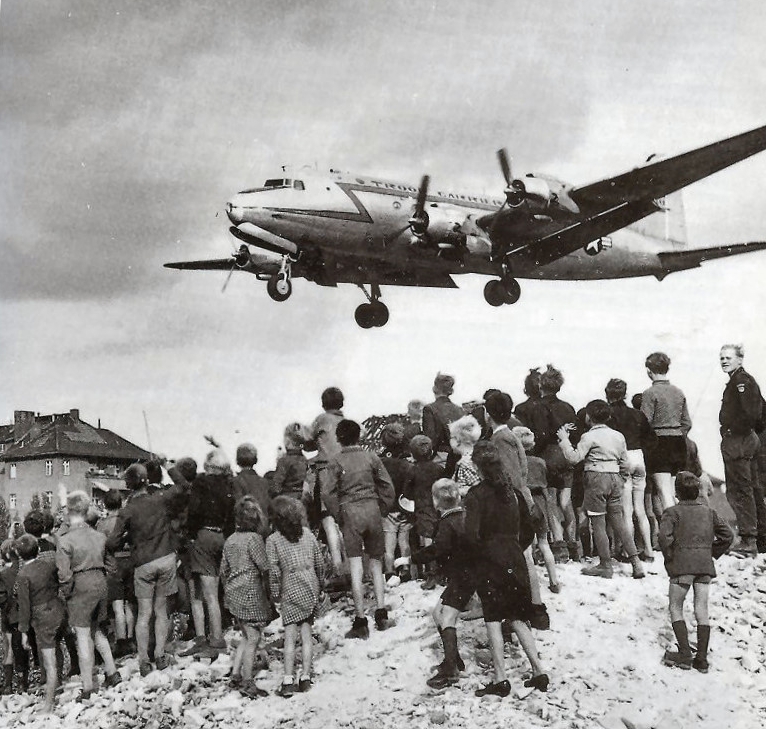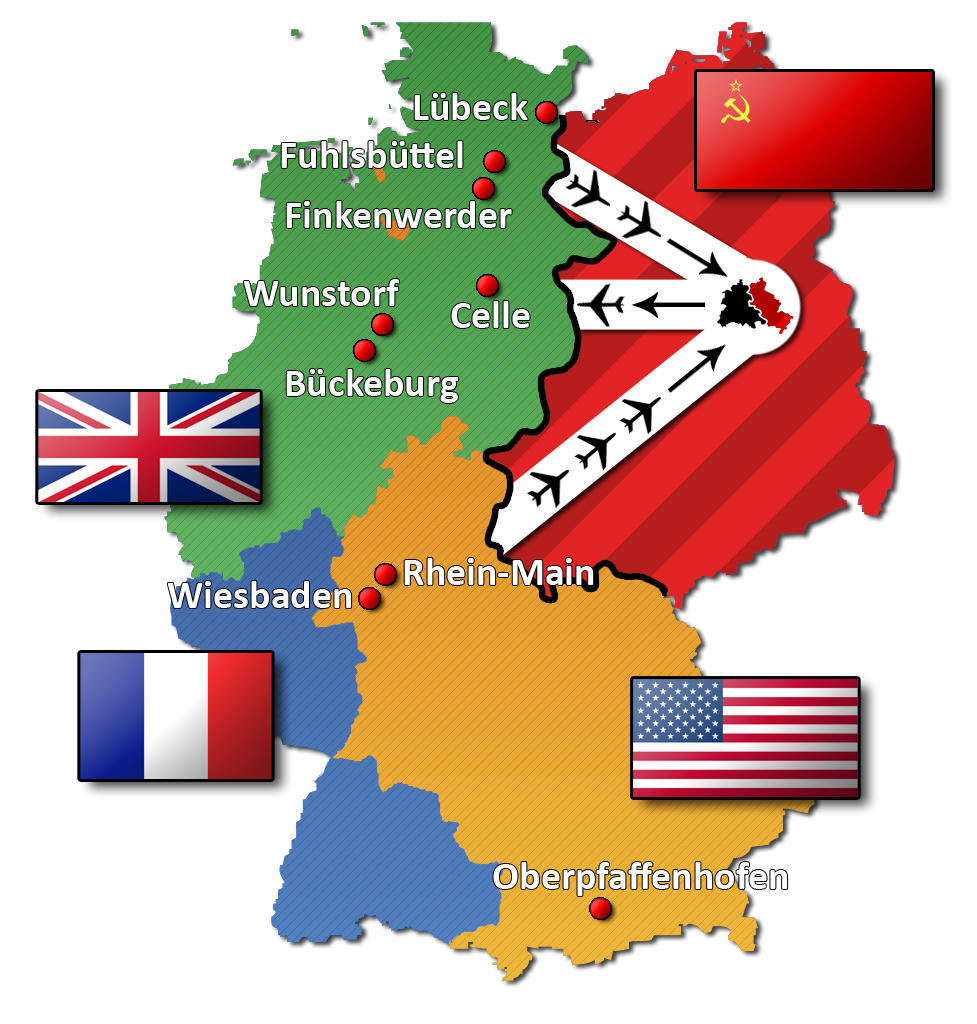 On the outbreak of the Cold War (a new type of conflict of gestures, speeches and doctrines) in the summer of 1948, the USSR decided to escalate the looming conflict by implementing in West Berlin – administered by its former WW2 Allies - a total blockade. The Berlin Blockade would be the first radical move which laid the relations between the two worlds – Communist and Democrat – on new grounds for almost half a century. The Berlin Blockade had also foreseen the division of the German State in 1949 in West Germany (FRG/BRD) and East Germany (GDR/DDR) as well as its capital by building the Berlin Wall.
On the outbreak of the Cold War (a new type of conflict of gestures, speeches and doctrines) in the summer of 1948, the USSR decided to escalate the looming conflict by implementing in West Berlin – administered by its former WW2 Allies - a total blockade. The Berlin Blockade would be the first radical move which laid the relations between the two worlds – Communist and Democrat – on new grounds for almost half a century. The Berlin Blockade had also foreseen the division of the German State in 1949 in West Germany (FRG/BRD) and East Germany (GDR/DDR) as well as its capital by building the Berlin Wall.
At the end of the Second World War, Germany was divided into spheres of influence: the US, the USSR, the UK and France accepted the Nazi surrender and went on to administer certain territories, in order to impose order. The USSR occupied the east of the country, whereas the other Allied powers administered the western part of Germany.
The same logic was applied to the Capital which was sectioned into four occupation areas. Almost 2,25 million people lived in the areas the West administered, whereas the military forces rose up to almost 11.000 soldiers from which 6.500 were Americans. In order to ensure their survival, almost 30.000 tons of foodstuffs, construction materials and other goods were brought to the Western side of the Capital, which was mainly industrialized and it could not offer the necessary resources.
The Berlin Blockade had been sealed at the Yalta Conference
Immediately after the end of the WW2, the USSR and the US started having totally different and opposed opinions about the future of the German state. The Soviets were interested in receiving as much money as possible as war reparations and also, in disarming Germany. The Americans were more realists and accommodating and thought that there must be a powerful, unified Germany, in order to see Western Europe rebuilt economically. Also, the US was interested in rearming Germany so as to stop an eventual attack of the Soviet troops on the West.
On the Soviet side, the hostile feelings were aggravated by the implementation of the Marshall Plan. It was considered a financial extension of the Truman Plan and it was destined for the European recovery through which the US was able “to support free peoples who are resisting attempted subjugation by armed minorities or by outside pressures”. Also, at the London Conferences of the winter and spring of 1948, the US asked for a monetary reform, in order to build a unified West Germany.

The Soviets Protected Berlin’s Economy from the Anglo-Americans
Therefore, the Berlin Blockade appeared as a consequence of the different visions and attitudes of the former WW2 Allies, although the London Program played a significant role compared to the other motives. On March 6th, the communique regarding the aid for West Berlin was released publicly and from April, the Soviets decided to restrict in their area the Western Allies’ military aid in Berlin. On April 5th, 1948, the Romanian newspaper ”Scânteia” presented the Soviet explanation of what was happening in Berlin: “The Soviet Command instructed the Berlin tribunal to take immediate measures, in order to stop these illegal actions of the industrialists and those who speculate and who threaten Berlin’s economy. For its part, the Soviet command took all the necessary measures against clandestine transports of goods to the Western areas. Should the tribunal keep the same attitude towards these crimes, the Soviet Command would have to take even more drastic measures.”
Thus, the West was pressured to either surrender to the Soviet ambitions and give up Berlin – which would have affected their prestige and status – or they would remain in Berlin, in order to implement the monetary reform. Thus, the Allies decided to fulfil the plans set out at the London and therefore, introduced in West Germany the new Ost Mark currency. The Romanian newspaper announced on June 24th that the Soviets were pressured to take these measures, because of the Western Allies’ actions: “Suspension of the passenger railway traffic between the Soviet occupation zone and the Western areas; the entrance of any kind of vehicles and horse powered vehicles from all other areas, including the traffic on the Helmstedt – Berlin highway; All means oftransportationon water travelling fromtheSoviettoWesternareasand vice versamust obtain a permit from thehead ofthe transportdepartmentofthe Sovietmilitary administrationandwillbe allowed togoonlyafter apreliminaryinspectiononthe cargo andvesselpersonnel; Freighttrain trafficwill continueunhindered, provided apreliminaryinspectionof the cargoas well astrainstaff andguard. All these measurescome intoforce on 18 Juneat midnight.”
Stalin: “We are still Allies”
What the Romanian newspaper was not writing in its issue of June 24th was that on the same day, immediately after the new currency was introduced, the Soviet authorities imposed in Berlin a complete blockade: every highway and railway that were connected to Berlin were closed to traffic. In so doing, the Soviets did not actually infringe on any kind of international norm, because they based their decision on a detail which did not probably occur to the Western Allies: the USSR, the UK, the US and France had never signed a pact which would regulate the access to the Western side of Berlin. Although the situation was tense, Stalin had never given ultimatums neither in the beginning, nor during crisis and this left the door open to negotiations. He even whispered to a Western diplomat during the blockade that “We Are Still Allies”.
While West Berlin was gradually suffering from insufficient food and medical supplies, President Harry Truman’s advisers began thinking that maybe the moment of diplomatic relations with the Soviet Union was a bygone era. Yet, the world was anxiously waiting on a Soviet – American confrontation. However, the Western Allies were not discouraged by the situation created by the Soviets and decided to implement an ample aerial transport action which ensured that the Germans who dwelled in West Berlin had everything they needed to live properly – such as coal and food supplies. 13.000 tons of supplies were airlifted during 324 days and this became known as one of the greatest logistic efforts in history.
However, it was clear in 1949 that
Uncle Joe’s objectives were not going to be met. The US continued to implement measures against the blockade: West Germany was preparing for a new rule and in Washington, the Treaty for the North Atlantic Treaty-Organization was signed. Therefore, in May 1949 after a meeting of the Foreign Ministers, Stalin approved of the termination of the Berlin blockade.













Pentru a putea adăuga comentarii trebuie să fii membru al altmarius !
Alătură-te reţelei altmarius